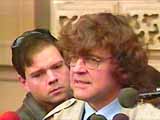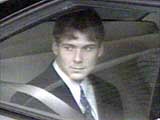INDEPTH: ROBERT BALTOVICH
Baltovich trial timeline
CBC News Online | July 15, 2005

Robert Baltovich |
In June 1990, Robert Baltovich was 24 years old. A recent graduate from the
University of Toronto's Scarborough campus, he had majored in psychology. He was
hoping to land a summer job and spend some time considering graduate school.
But on June 19, his girlfriend, Elizabeth Bain, 22, vanished and Baltovich's
path changed forever. Two years later Baltovich was convicted of killing Bain.
Her body was never found.
Baltovich has always insisted he is innocent. During the original trial,
Baltovich's lawyers suggested the so-called "Scarborough rapist" might
have killed Bain. Several witnesses testified they saw Bain with a blond man in
the days before she vanished.
Today, police and the public know that rapist was Paul Bernardo. Since
Baltovich's original trial, media reports and a book have pointed out links
between Bernardo and Bain.
Such links are also said to be the basis of the "fresh evidence" for
Baltovich's appeal.
While there is a publication ban on some of the evidence relating to the appeal,
Baltovich's lawyer, James Lockyer, has said the new evidence points the finger
at Bernardo.
Robert Baltovich is now 39. He is currently out on bail, awaiting a decision by
the Crown whether to proceed with a new trial.
July 15, 2005:
Ontario’s Ministry of the Attorney General announces that Baltovich will face
a new trial in the killing of Elizabeth Bain. He will face a charge of
second-degree murder.
December 2, 2004:
The Ontario Court of Appeal sets aside Baltovich's conviction and orders a
new trial. The court rules that the trial judge’s charge to the jury was
unfair and unbalanced and contained significant legal errors that were
prejudicial to Baltovich. Baltovich's lawyer had asked the Court of
Appeal to acquit his client. But the Court said it was not persuaded that an
acquittal was appropriate given that there is evidence upon which a properly
instructed jury could reasonably convict.
September 20, 2004:
The Ontario Court of Appeal begins a hearing into Robert Baltovich's conviction
in the death of Elizabeth Bain. It has been 12 years since he was convicted at
his original trial.
April 19, 2004:
Baltovich's appeal hearing is scheduled to begin, but is delayed until
September.

Elizabeth Bain |
April 24, 2003:
Justice Marc Rosenberg rules that Baltovich's lawyer, James Lockyer, cannot
participate in the portion of the Baltovich appeal in which Paul Bernardo is
portrayed as the real killer of Elizabeth Bain. Bernardo, supported by the
Ontario Crown, had objected to Lockyer being involved in the appeal because
Lockyer had represented Bernardo in 1996-1997. A compromise is struck: one of
Baltovich's other lawyers, Brian Greenspan, is to pursue the Bernardo-related
aspects of the case, while Lockyer is to represent Baltovich in all other
aspects of the case.
March 31, 2000:
Exactly eight years after being convicted of murdering his girlfriend, Robert
Baltovich is released on bail, pending an appeal of his March 31, 1992,
conviction. "It's a great feeling," Baltovich told reporters who
swarmed around as he walked down a busy street in downtown Toronto. "Jail
isn't a pleasant place." In his written reasons Justice Marc Rosenberg
said, "the case against the applicant was wholly circumstantial." He
added that Baltovich's lawyer, James Lockyer, had "urged me to approach
this case on the basis that there is a reasonable possibility that an innocent
man has been convicted."
» MORE
March 15, 2000:
By this time, James Lockyer, the director of the Association in the Defence of
the Wrongly Convicted, has joined Baltovich's defence team. On March 15, 2000, a
390-page defence brief is filed with the Ontario Court of Appeal. During
Baltovich's bail hearing, his lawyers argue there is new evidence to suggest
that he did not kill Elizabeth Bain. They contend Paul Bernardo did it, and
argue Baltovich must be released on bail while he waits for his appeal.
Some details of the new evidence can't be revealed because of a publication ban.
But the private investigator in the case, Brian King, described it at the time
this way: "It's based on an overwhelming amount of a lot of different
things. Not just one thing like forensic evidence, but say a combination of
interviews and information that has come forward since the trial."
» MORE
1998:
The book No Claim to Mercy is published. Author Derek Finkle presents
details of the connection between Bain and Bernardo.
February 1997:
Baltovich's appeal is scheduled to begin, but it is postponed indefinitely.
May 16, 1996:
Baltovich's lawyers file materials with the Ontario Court of Appeal. The fat,
sealed envelopes contain "fresh evidence" obtained by Baltovich's
defence team between 1992 and 1996. A 113-page memorandum is submitted to the
court in late May. It does not make reference to Paul Bernardo by name, but says
it is the position of the defence "that another individual, other than the
appellant, committed the offence." The memorandum says the new evidence
"relates to the evidence adduced at trial concerning the 'Scarborough
rapist.'"
Sept. 1, 1995:
Paul Bernardo is found guilty on nine charges relating to the deaths of Leslie
Mahaffy, Kristen French and Tammy Homolka. He is sentenced to a life term in
prison and is later declared a dangerous offender, which effectively means he
will never be let out.
From CBC Newsworld Flashback: Paul
Bernardo convicted in sex slayings of two Ontario teens (Real Video)
February 1993:
Paul Bernardo is charged in connection with the Scarborough rapes. Baltovich's
lawyer asks a private investigator, Brian King, to focus on evidence relating to
Bernardo and any connection he may have had with Elizabeth Bain. In October
1993, King tells the Toronto Star newspaper that he has uncovered
"startling" findings that could help free Baltovich.
May 1992:
Baltovich's new lawyer, Brian Greenspan, files an appeal of the case. The notice
cites 22 grounds for why Baltovich's conviction should be set aside, including
problems with the judge's address to the jury and the use of "hypnotically
enhanced memory" testimony of witnesses. Baltovich is denied bail pending
his appeal.

James Lockyer |
March 31, 1992:
The jury finds Robert Baltovich guilty of second-degree murder. Elizabeth's
parents, Ricardo and Julita Bain, tell reporters they're relieved by the verdict
and say they hope Baltovich will tell authorities where they can find
Elizabeth's body. Baltovich is later sentenced to life in prison.
Feb. 4, 1992:
Baltovich's first trial begins before Justice John O'Driscoll. The trial lasts
six weeks and jurors hear testimony from more than 100 witnesses. The charge
against Baltovich has been dropped to second-degree murder. He pleads not
guilty.
Crown Attorney John McMahon portrays Baltovich as a jealous and obsessed
boyfriend, who murdered Bain when she tried to break off their relationship.
Baltovich's lawyer, William Gatward, argues that the evidence in the case
suggests someone other than his client could have killed Elizabeth, including
the "unidentified blond man" several witnesses had reportedly seen her
with before she disappeared. The possibility that the so-called
"Scarborough rapist" could have been involved is also raised. Gatward
tells the court that the rapist last struck in May 1990, and he had not been
known to have attacked anyone since Bain disappeared.

Brian King |
Nov. 19, 1990:
Five months to the day after Elizabeth Bain disappeared, Robert Baltovich is
arrested and charged with first-degree murder.
July 25, 1990:
Police search Baltovich's house and impound his car. They seize several letters
between Bain and Baltovich, some of his personal writings, a magazine, and
several items of his clothing. The Baltovichs' phone is bugged.
July 11, 1990:
On what would have been Elizabeth Bain's 23rd birthday, her parents, Ricardo and
Julita Bain, hold a press conference in the backyard of their suburban Toronto
home. They beg her abductor to bring her home – or reveal where her body may
be found.
Summer 1990:
After Bain's disappearance, police, her family and volunteers conduct massive
searches of ravines, wooded areas and creeks throughout the Toronto region.
Elizabeth Bain's body has never been found.
Also during the summer of 1990, homicide investigators employ a controversial
method, "hypnotically enhanced memory," with several witnesses who saw
Bain or Baltovich before she disappeared. Witnesses are hypnotized and
questioned about their recollections.
June 24, 1990:
Baltovich provides police with forensic samples. Detective Sergeants Steve
Reesor and Brian Raybould interview him for several hours. Afterwards, Reesor
creates a list in which he cites 10 discrepancies he finds with Baltovich's
version of events.

Paul Bernardo |
June 22, 1990:
Bain's silver 1981 Toyota Tercel is found parked outside an auto body shop just
a kilometre from her home. There is a large bloodstain on the floor of the
backseat. The Metro Toronto Police homicide squad takes over the investigation.
Baltovich is put under surveillance.
June 20, 1990:
Julita Bain reports her daughter missing to police at 6:45 a.m.
Tuesday, June 19, 1990:
Elizabeth Bain, 22, vanishes sometime in the early evening. Her mother, Julita
Bain, says she last saw her daughter at 4 p.m. She says Elizabeth left the house
to "check the tennis schedule" at the University of Toronto
Scarborough campus.
Source
www.OttawaMensCentre.com
613-797-3237





